**This post describes an entirely hypothetical asteroid impact scenario, playing out during this year’s Planetary Defense Conference**
Daily updates are added to the top of the bottom of the page. Scroll down to get the latest
Setting the scene: Planetary Defense Conference 2021
Every two years, asteroid experts from across the globe come together to pretend an asteroid impact is imminent. During these week-long impact scenarios, participants don’t know how the situation will evolve know from one day to the next but must make plans based on the daily updates they are given.
For only the second time in the conference’s history, ESA will be live tweeting the hypothetical impact scenario – so you’ll find out the ‘news’ as the experts do. What will they do? What would you do?
This year’s asteroid – ‘2021 PDC’
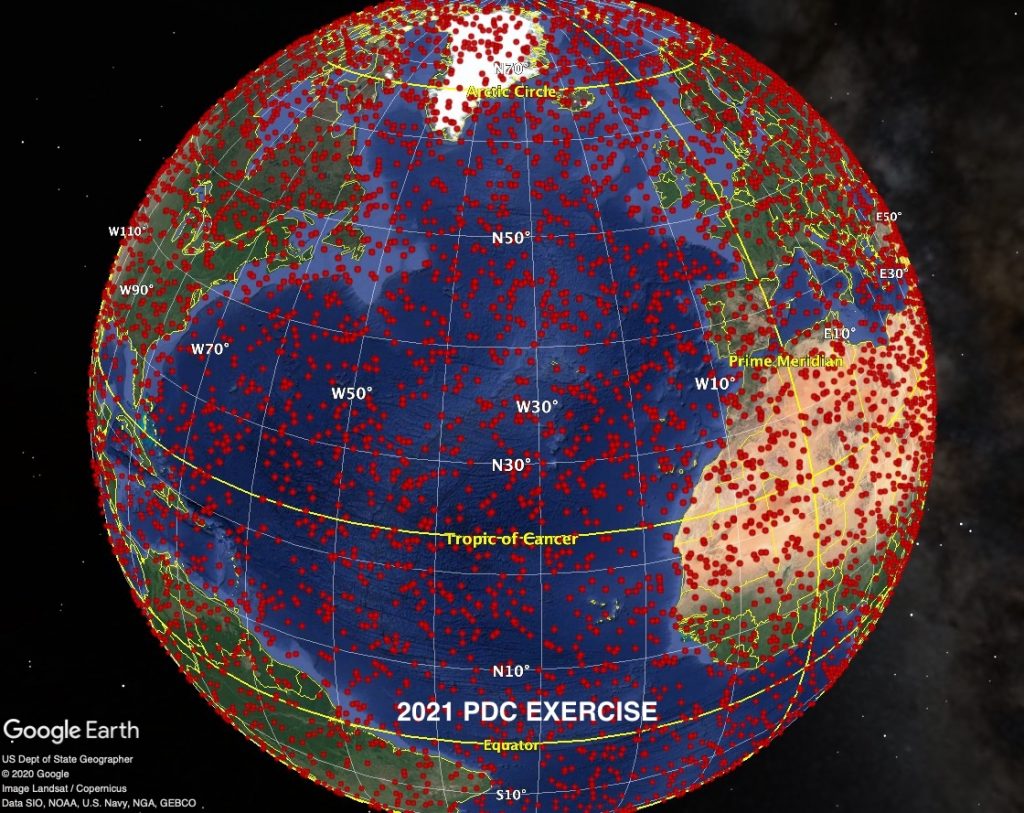
— An asteroid was discovered on 19 April 2021 and has been given the name “2021 PDC” by the IAU’s Minor Planet Center.
— The day after 2021 PDC is discovered, NASA and ESA ‘impact monitoring systems’ identify several future dates when this asteroid could potentially impact the Earth. Both agree the most likely potential impact is on 20 October 2021 – just 6 months away.
— The probability of that impact is about 1 in 2500. With only two days of tracking on this object, no better estimate of impact probability can be made.
— Very little is known about the physical properties of 2021 PDC. Its size, in particular, is highly uncertain. Its ‘apparent magnitude’ suggests an asteroid of about 120 meters in size. But it could range from 35 – 700 metres!
— Astronomers continue to track the asteroid every night after discovery, and the impact probability steadily increases. As of April 26, 2021, the first day of the 2021 Planetary Defense Conference, the probability of impact has climbed to about 5%. The rest of the scenario will be played out at the conference.
DAY 1: Meet the asteroid – what’s the risk?
Day 1 of the Planetary Defense Conference and we looked in a little more detail at hypothetical asteroid 2021 PDC, as well as determining some initial ideas of the impact effects, if it were to strike.
Chance of impact: 5%
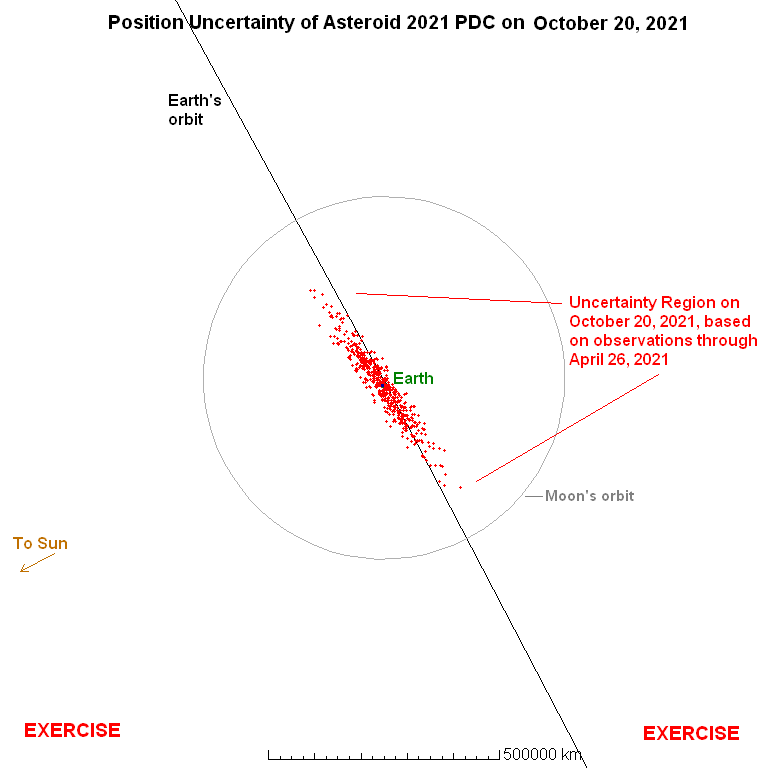
The red dots show possible positions of 2021 PDC on October 20, 2021, computed using just one week of tracking data since discovery. 5% of the red dots currently intersect Earth, giving a 1 in 20 chance of impact. As more observations are made, the uncertainty region will shrink.
Object size: highly uncertain.
Accounting for current uncertainties, fictional asteroid 2021 PDC could be as large as 700 m or as small as 35 m.
Potential impact zone: 2/3 of Earth’s surface
Based on current orbit knowledge, 2021 PDC could impact anywhere within a region that covers 2/3 of the Earth surface, shaded here in red/purple.
Effect of potential impact:
The worst case scenario for 2021 PDC is it measures 700 m in size. Such an asteroid striking Earth would have catastrophic results, although it is beneath the 1 km threshold for a possible global catastrophe. Best case? At 35 m the asteroid, if it strikes, would cause a major airbust if it broke up in the atmosphere up to devastation on a local scale.
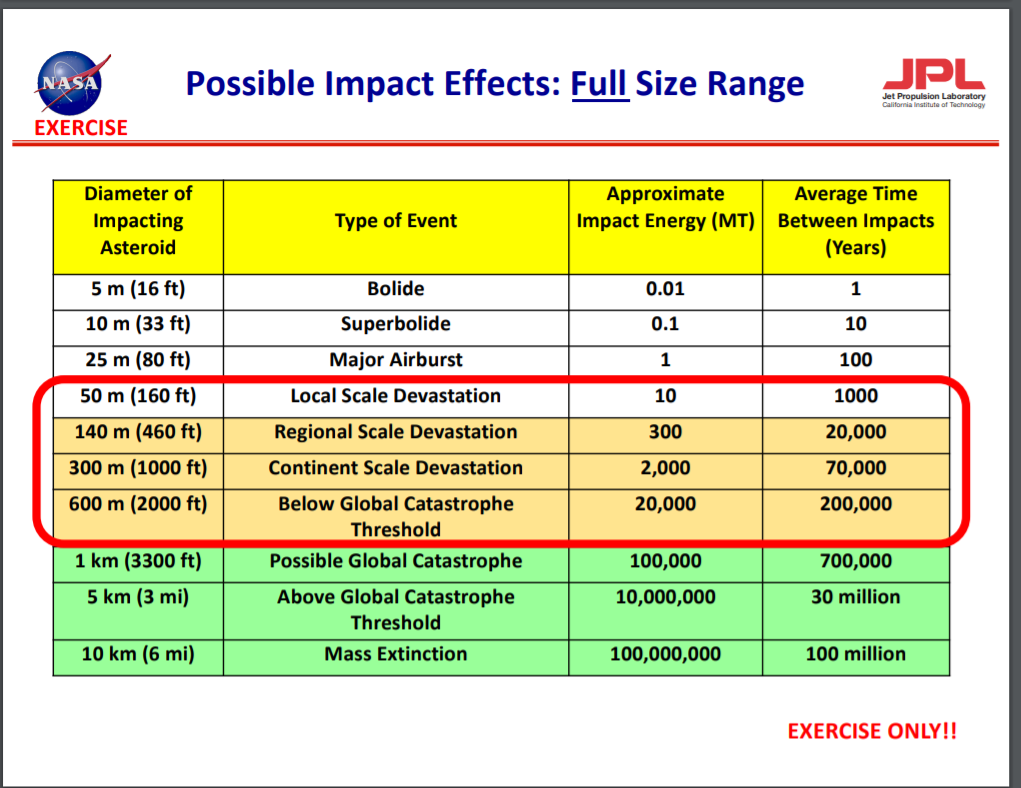
If we take an average size of ~150 m, what kind of damage could 2021 PDC do? Anywhere from 0 – 86 million people could be affected. Damage from the blast is the predominant hazard, while heat damage and tsunamis are possible, although less likely and severe.
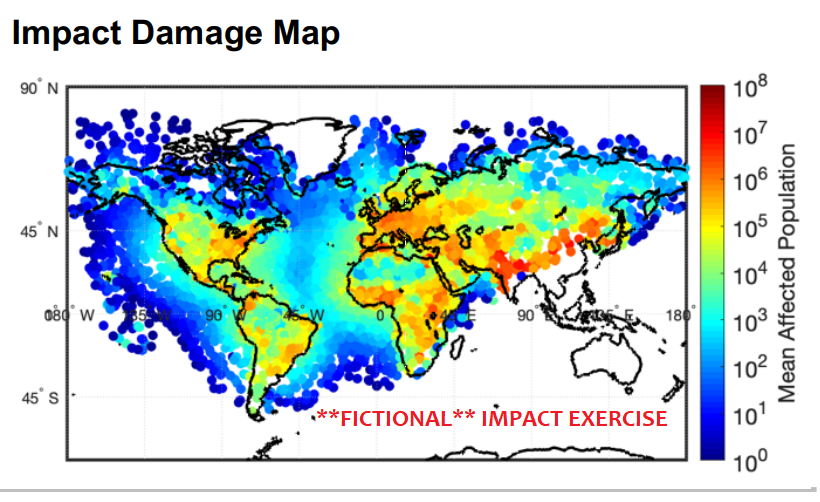
The primary hazard is the airburst/impact causing blast ‘overpressure’, resulting in minor structural damage to potentially unsurvivable levels
The expected area of damage would have a radius ot 0–500 km, ~90 km on average. However, the chance of impact is still slim, meaning there is a 97% chance of no damage, with small chances that an impact could affect thousands to millions of people.
Follow our live twitter updates.
Day 2: New observations confirm *fictional *asteroid will impact
In our hypothetical scenario, one week has past and we are now on 2 May, 2021. New observations confirm that fictional asteroid 2021 PDC will strike Earth in six months. Regions at risk include Europe and Northern Africa. What will the international community do next?
Impact probability: 100 %
Date of impact: 20 October 2021, 17:13 UTC +/- 82 s
Object size: still highly uncertain
Accounting for current uncertainties, the asteroid could still be as large as 700 m or as small as 35 m.
Impact region/location:
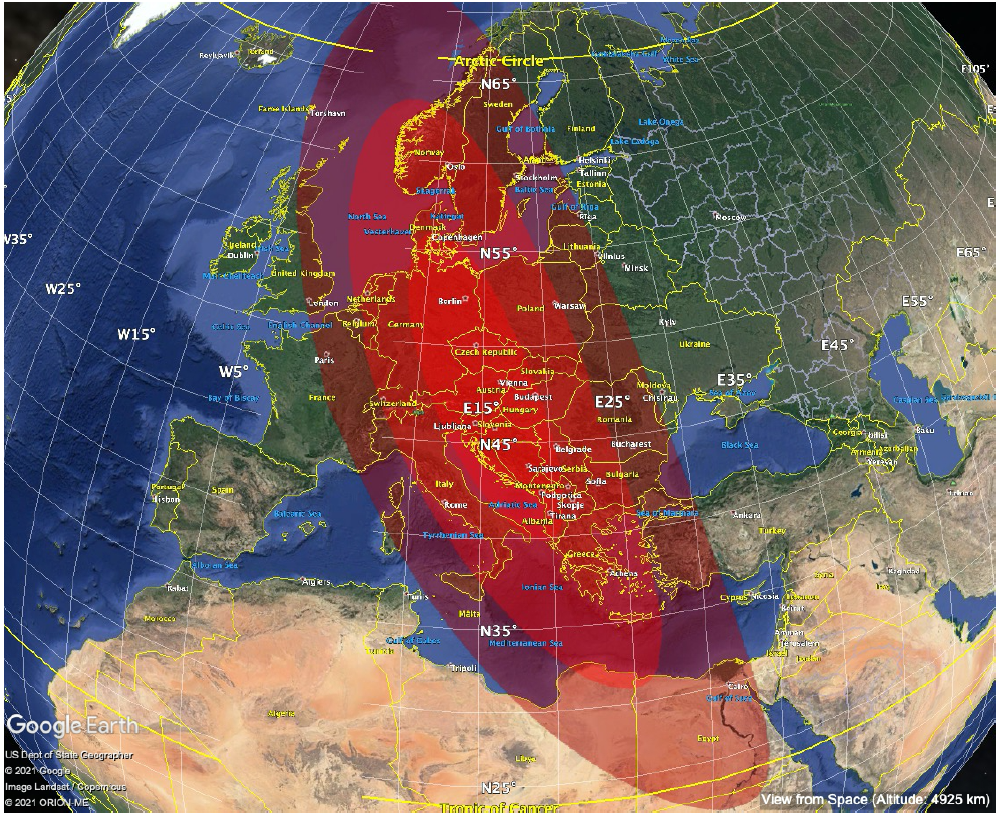
Somewhere within a large region covering much of Europe and extending into northern Africa. Countries most at risk include Denmark, Germany, Czech Republic, Austria, Slovakia, Hungary, Slovenia, Croatia, Serbia, Montenegro and Albania. The region extends on the north to Norway and Sweden, on the west, to England, France and Italy, on the east, to countries including Lithuania, Poland, Ukraine, Romania and Bulgaria, and on the south, to Greece and Egypt.
Size of Damage Area Around Impact Site: Highly uncertain
Depending on the object size, severe damage from the airblast could extend anywhere from “Minimal” (a few kilometers) to “Local” (tens of kilometers) to “Regional” (hundreds of kilometers).
So, what next?
What are our options for a space mission?
The Space Missions Planning and Advisory Group (SMPAG) – an international forum of space agencies – is considering the feasibility of space missions as a coordinated international response to 2021 PDC – the main issues are: time is limited and we do not have a clear idea of the size of the asteroid.
Because of the very short time until the fictional impact, our options are limited. Most of the options described in day 1’s Twitter poll are most effective when used to nudge the asteroid gently, resulting in a notable change of direction that builds up over time.
However, the force required to shift fictional asteroid 2021 PDC off a collision course with Earth is so large it risks breaking up the asteroid – perhaps creating multiple large fragments that could impact Earth.
Current options available are to send a reconnaissance mission (to get more info on the imagined asteroid), and/or send a mission with a nuclear explosive device of 4.5 million tonnes – the deliverable yield of a high-speed intercept mission.
However, various international laws rule out use of nuclear weapons in space. So, what will the international community do?
Day 3: Mission impossible
It’s day three of the Planetary Defense Conference and there are new – not-so-positive – developments playing out in the fictional impact scenario. We now jump ahead two months to 30 June, less than four months until imaginary asteroid 2021 PDC is due to strike Earth. New space-based infrared measurements have improved our understanding of the asteroid’s impact effects.
The fictional impact is expected to occur somewhere within an area of central Europe roughly 800 km long by 250 km wide. Countries at risk include Germany, Czech Republic, Austria, Slovenia and Croatia.
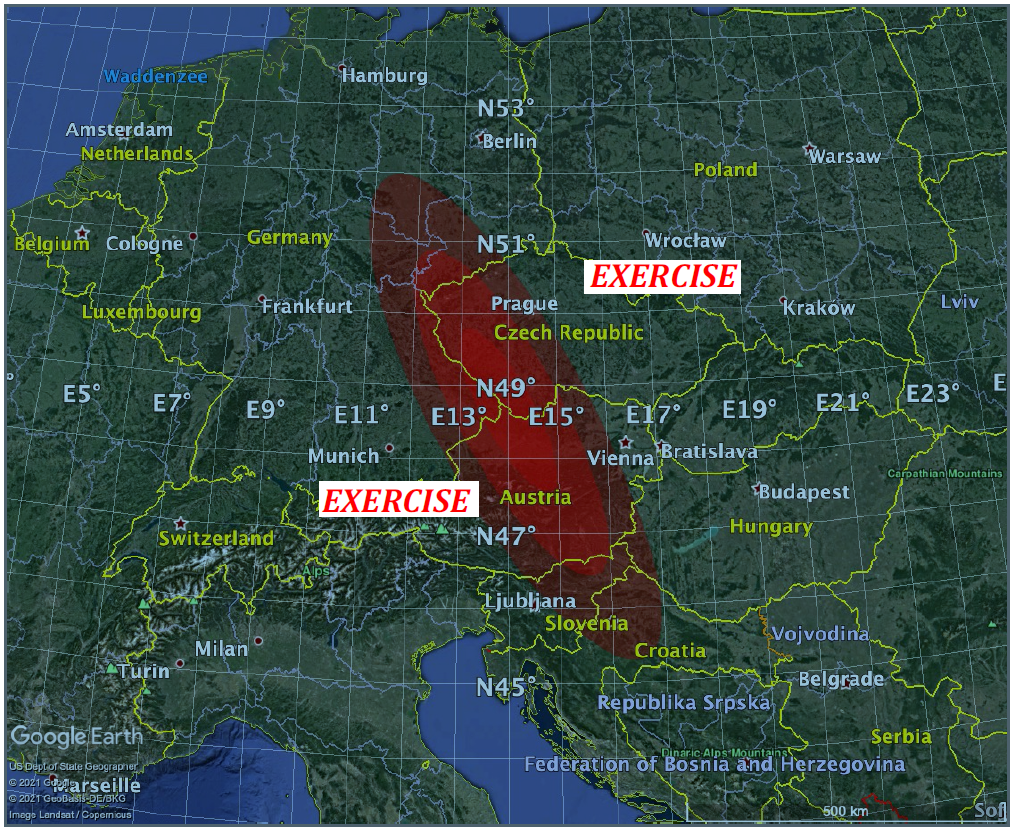
So what about the size of the imaginary asteroid? New measurements by the NEOWISE satellite indicate 2021 PDC cannot be as large as previously thought possible. The new size range is anywhere from 30 – 500 m.
Taking an average size for the asteroid of 136 m – what kind of damage could we expect? Anywhere from 0 – 6.6 million people could be affected. The primary hazards are the airburst and impact, which would damage a region up to 250 km
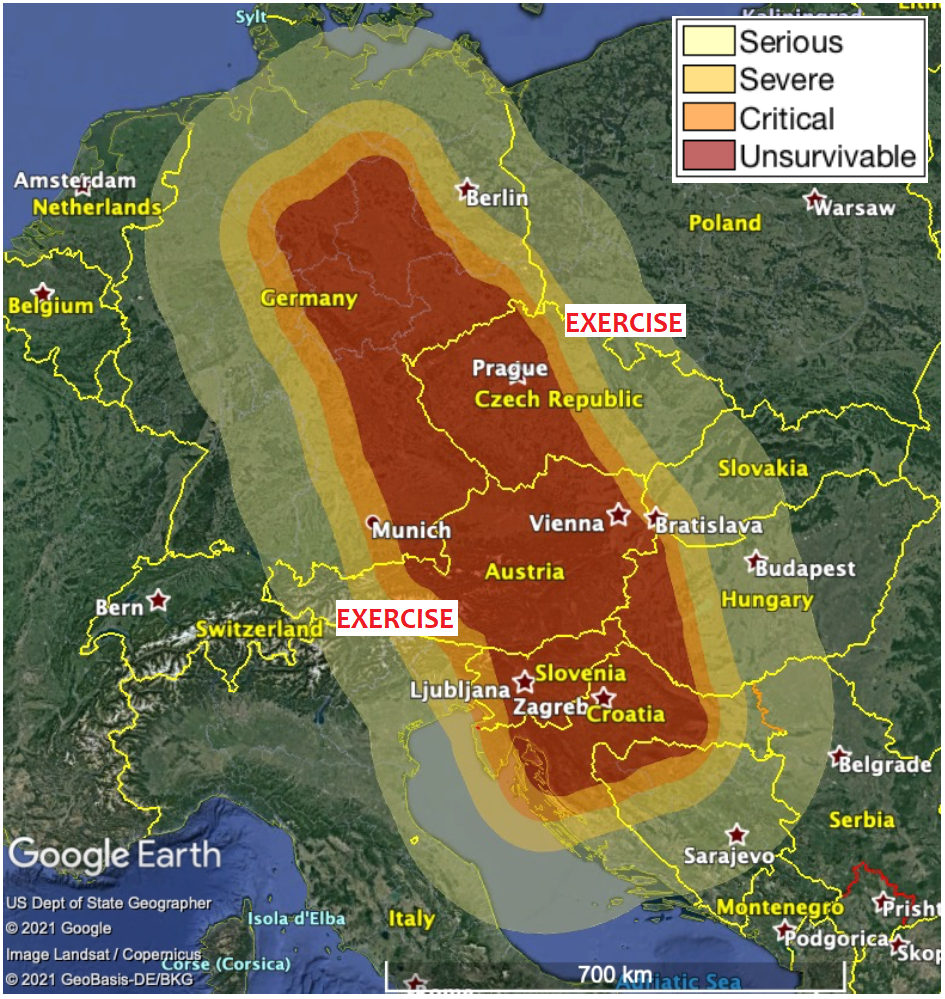
So … what about the possibillity of a space mission to deal with the asteroid? The Space Missions Planning and Advisory Group (SMPAG) has concluded that no space missions can be launched to fictional asteroid 2021 PDC in time to deflect or disrupt it.
Day 4
In our fictional impact scenario, the date is now 14 October 2021, six days before imaginary asteroid 2021 PDC impacts Earth. The asteroid is currently 6.3 million km away, heading for Earth at a speed of 10.7 km/s.
Chance of impact: 100%
Size of object: New radar images show the size of 2021 PDC to be 105 m +/- 10%
Impact velocty: 15.2 km/s
Impact location: A region about 23 km across, centered near the borders of three countries – Germany, Czech Republich and Austria. The impact location can be predicted to within 23 km, and time to within one second.
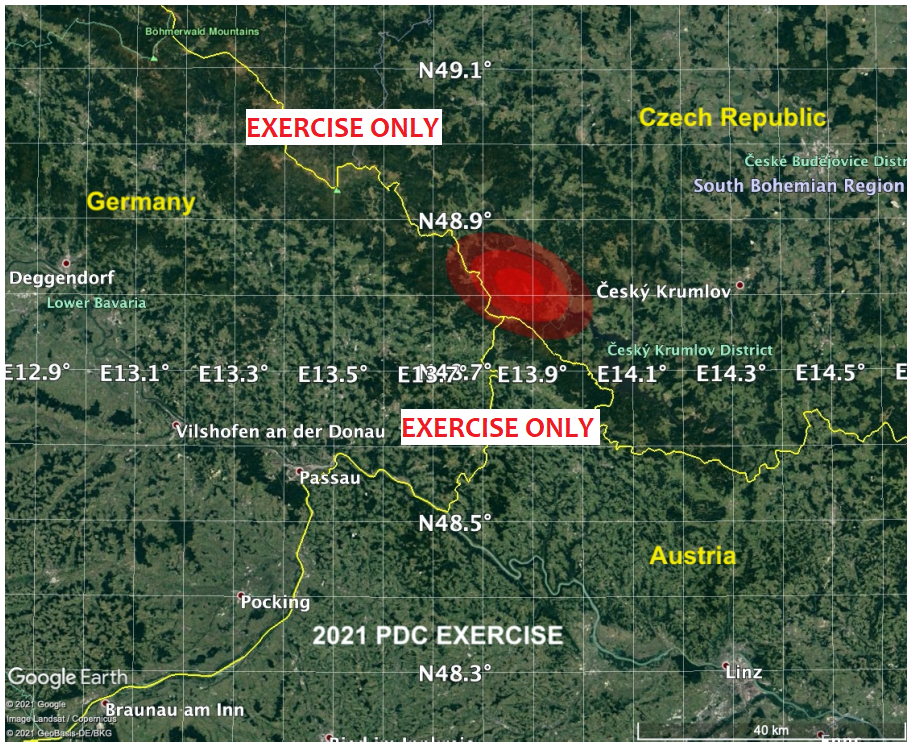
The following image shows the region of potential damage risk, which is much larger than the region in the previous image because serious damage could extend for up to a hundred kilometers or so from the impact point. In the highest impact-energy case, the region for serious potential damage risk is about 300 km across, as indicated by the
shaded region; the extent of serious damage for the average case, indicated by the line contours, is about 150 km across.
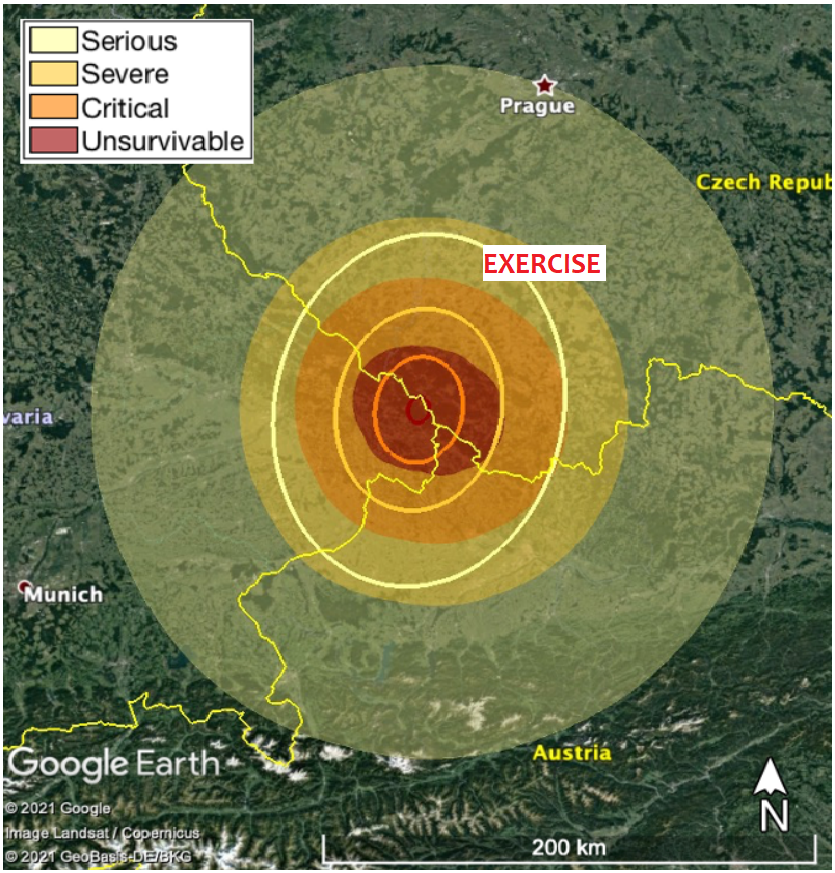
Day 5: Lessons learnt
Read our full lessons learnt, here.

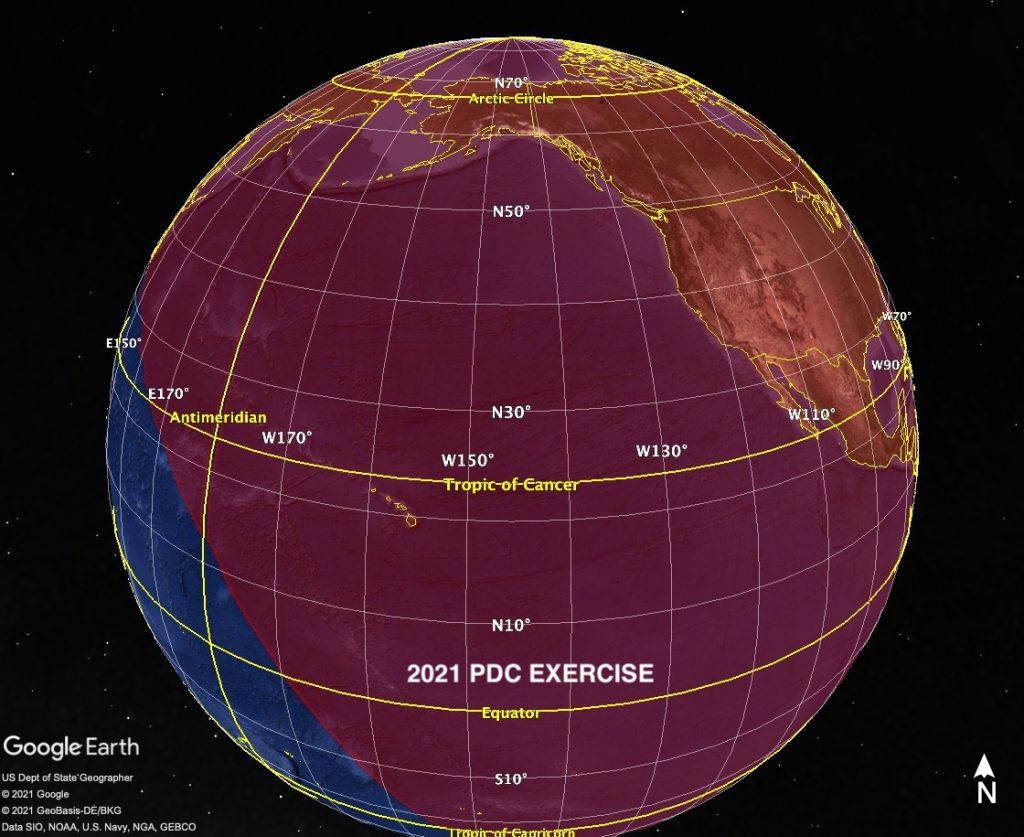
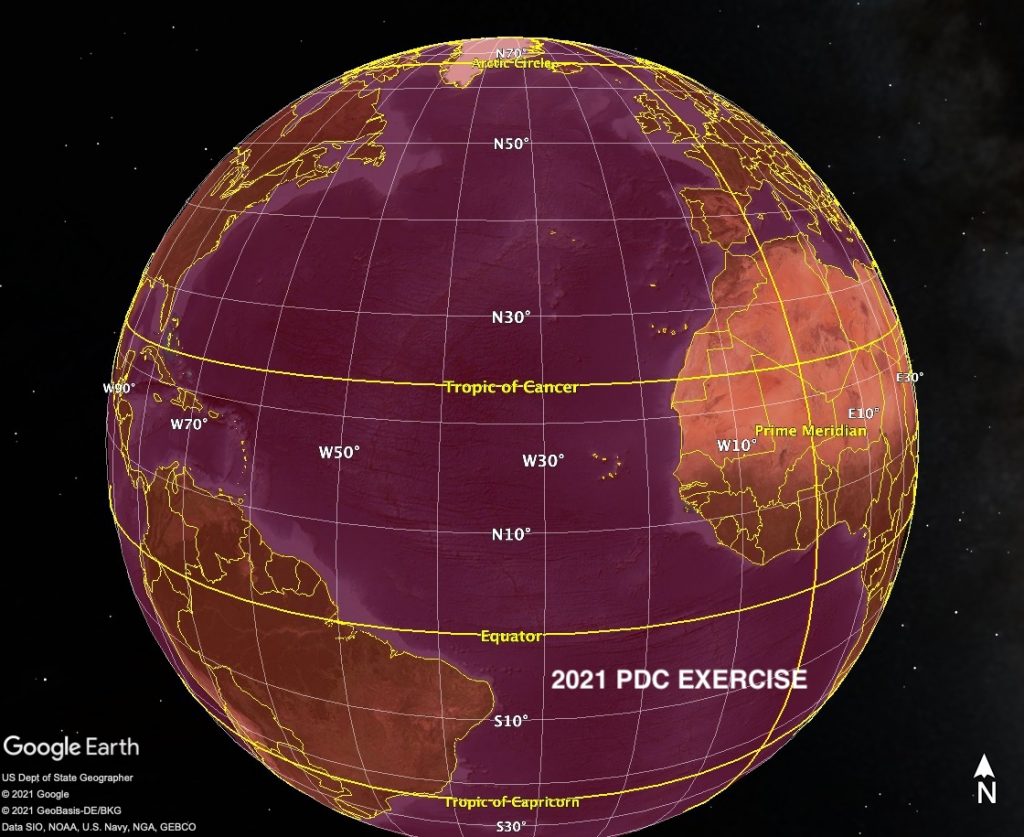
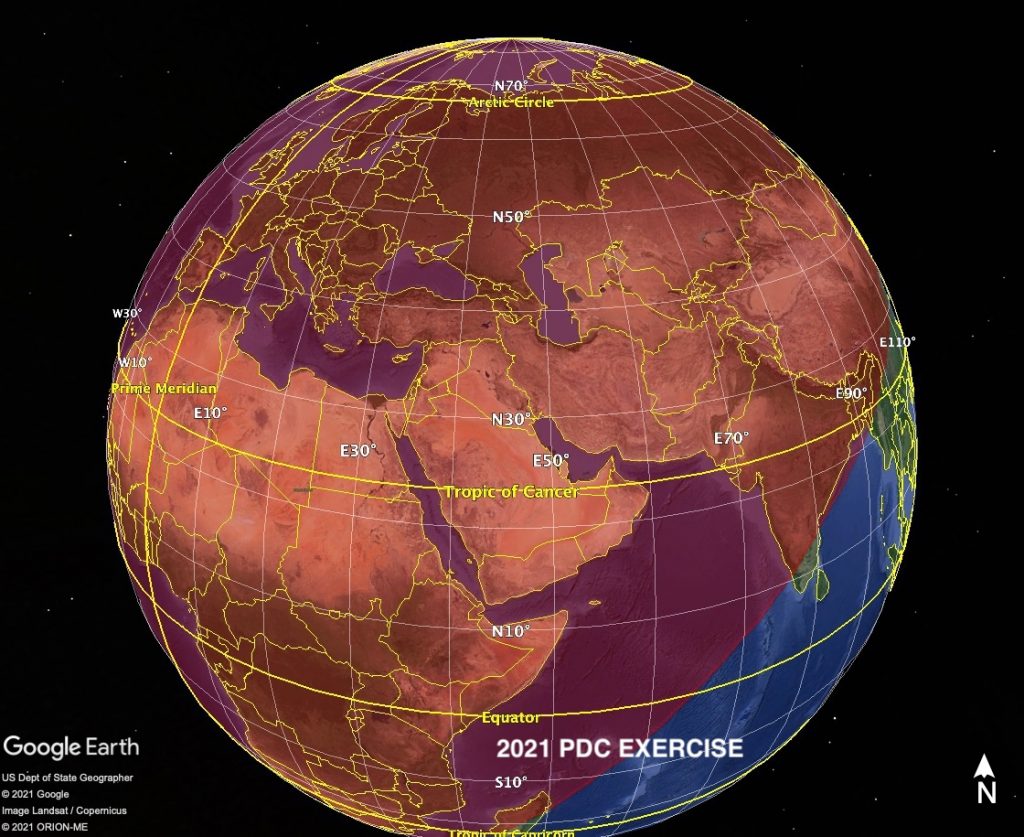
Discussion: 11 comments
That’s cool but, what if You add IFRC for a global Red Cross supported exercise then adquire real time data about our impact first-respond readiness. ( I served 20 as Red Cross Volunteer un Colombia and I never heard about an “Asteroid Impact Protocol”)
“Hypothetical”…
they are warning us because you know that soon something is going to fall on us.
Maybe 2027?
Suggest 41deg. 2.422’S 173deg 39.028’E for fake impact of part of asteroid.
Haha, what did New Zealand do for you?
Why you detele some messages?
Ganz Deutschland innerhalb eines halben Jahres evakuieren ???
How can we stop this Asteroid? I don’t wanna die!
The first conclusion we can draw is that, in general, we are not prepared to detect an asteroid (2013-Chelyabinsk (Russia). Therefore, the first thing to do should be to establish an effective detection system. Where to establish it? near to the Principle Belt Asteroid that we occupy: Mars. Secondly, to immediately choose a system that could rapidly change the trajectory of an asteroid, preferably not destructive, for example with installed high-power laser emitters. on Mars, to direct energy to the possible impactor.
Thank you very much!
Did NASA and esa ask Roskosmos respective China, if they have a carrier for such a 4.5 Mt warhead? I know, this is more a desperate trial but a really hopeful action, but it would be the only option at all instead accepting impact. – A special allowance/excption by UN could be requested, because it is indeed forbidden to explode nukes in space.
I only ever see them working out where the object will be in relation to the Earth, do they take into account where the Moon will be prior to a possible impact.
RON
Estaría genial que hagan una traducción al español para que pueda llegar a mucha más gente.
Please I want read this at Spanish.